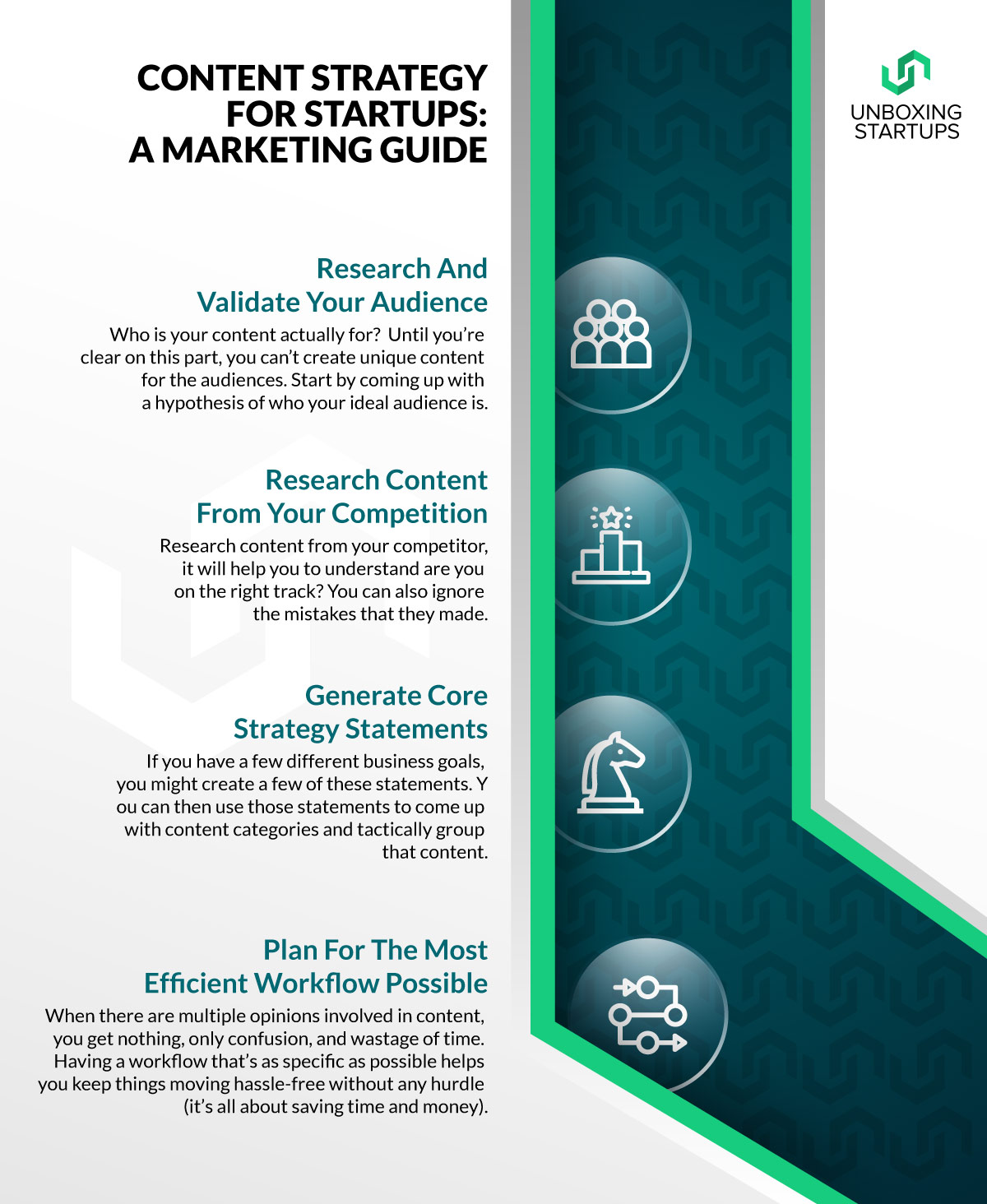
Content Strategy for Startups: A Marketing Guide
| 6 minutes read
Most startups and other companies create content, but the chances are that it costs more money than it’s worth. Yes! That’s true because most of the startups fail because they don’t have an appropriate content strategy.
The biggest reason? Lack of strategy, reliance on guesswork, and copying the same work.
As a Content Strategist for startups, we have seen the types of problems that crummy content creates. We will spare you the horror stories, but the final takeout is that loads of money and talent is wasted—and ample opportunities miss the target.
We know many of your dreams are getting shattered but wait! Don’t be upset; we came here to give you some crucial information to reduce the wastage of money and give your startup an extra edge.
The great news is that creating better content doesn’t require a hefty budget. All you need is one person from your team who can write and plan like a content strategist. If he is mature and experienced, he can handle everything, which will not cost you much.
First, let’s bust the myth that more content = better results.
Creating content just to publish on the website is where most people go wrong. Yet, it happens all the time. Without proper planning about drafting content can cost loads of money and waste talent.
The problem starts when startups launch social media profiles; the panic begins when they feel they don’t have enough content to post consistently. The race starts like fast and furious; initially, everyone wants to be a social media beast. Due to this, they ignore entirely research, strategy, and testing. The result is that businesses end up with tons of content and not a lot of ROI. Remember, you are not here to write the content; you are here to take the startup’s name up through your effective and appealing content for your audience, which should also rank high on Google. Let the world should know about you.
Brainstorming content ideas is not called creative ideas; it’s gambling your time and effort. Sometimes it works, and sometimes it backfires.
How many times have you seen this in a content writer job description:
“This position will brainstorm content ideas for our blog, social media, etc.…”
Sound familiar? It should. Personally, we see this all the time for a wide variety of content-based roles. What’s worse, we know the phrase “brainstorm content ideas” isn’t said in jest; businesses invest time and money into content just because someone capriciously had an idea.
When you start developing a content strategy, there are a few questions to answer, we will try to answer those questions.
1- Who will be reading your content?
Ask yourself, who is the target audience for your content? For how many audiences you are making content? Just as your business might have more than one user type, your content strategy can accommodate more than one type of reader or viewer.
Using various content types will help you deliver different content to every type of audience you plan to target and engage everyone with your company with whom your business is.
Keep in mind if you are using a UGC content marketing campaign, you will want to use a content moderation team to make sure no inappropriate content gets posted.
2- What problem will you be solving for your audience(s)?
Before finalizing a final product, ask yourself what problem the product will solve for the audiences or customers. If some product is already solving customers’ problem, remember customers will not switch easily in this condition.
A sound content strategy helps people on both sides of your product: those who are still figuring out their main challenges and those who are already using your product to overcome these challenges. Your content strengthens the solution(s) you’re offering and makes your customers more qualified users of your product.
3- What makes you different from the rest?
Your competitors will have a similar product as yours, which means your potential customers need to know what makes yours better and unique — or, at least, different. Make them believe that your product is better. This is where content comes in.
In order to prove why your product is worth it, you need to prove why you’re worth listening to.
A Guide to content marketing for startups in Four Simple Steps
Instead of racing to create loads of content based on creative brainstorming, or as per your strategy. You’ll likely still need to test and iterate, which will help you to achieve the high-value content much quicker. Overall it all starts with research and dedication.
1- Research and validate your audience
Who is your content actually for? Until you’re clear on this part, you can’t create unique content for the audiences.
Start by coming up with a hypothesis of who your ideal audience is. There are online templates you can use (just search “persona template”), or you can create your own.
In your hypothesized persona, you know the basics like:
- How much does your audience know about your startup/product etc.?
- What are their pain points?
- What are their current offerings to that pain point? What questions do they need to answer about it?
- What content do they regularly intake (as it relates to your business/industry?)
- What channels do they scroll to find their content?
- What types of content do they like? Videos Or Blogs?
– A few effective ways to validate your persona
A quick note: When you are doing either of these options, make sure that your first question qualifies them. Does your product solve their problems? No? Move on.
Post in social media groups and find relevant people to interview. Offer something interesting for free that would be valuable to your target customer in exchange for a 15-20 minute interview, ideally over a video-conference platform like Zoom or Skype. Ask questions that will help validate the assumptions you made were true or not. Do a few user interviews like this way, then revise your persona.
Guerrilla interviews: Leave the office. Go out in the real world situation. Find an ideal place your theorized content consumer probably hangs out, then ask random people if they have a couple of minutes to talk. Interview a few people who qualify as per your norms, then revise your persona.
2- Research Content from your Competition
Let’s say, for example, you researched your audience and found that they really need and want content about any particular thing.
You know they like to read and watch articles and videos from your competitor and other competitors on YouTube. Now you must dig into the content on both places and make notes about what they do well, how you could do better, and what kind of content about [your topic] is missing from the internet. Extract a crucial point that you think could add more value to your content.
The goal is to compare:
- What information your audience wants?
- Whether or not that information already exists
Then —>
Figure out how you can fill an information gap or create the same information uniquely and insightful way.
3- Generate Core Strategy Statements
Woohoo! You did it. You’ve got ample information now to figure out the best type of content to create for your startup or any kind of business. You know now for whom your content is for, what they need, what they expect, and what content you can create to give them.
If you have a few different business goals, you might create a few of these statements. That’s great. In fact, you can then use those statements to come up with content categories and tactically group that content. For example, if you create a blog, you might end up with two different main blog categories.
4- Plan For The Most Efficient Workflow Possible
Lots of people have opinions about the content. Maybe your CEO, team manager, and PR person would all like to give input on content. Just ignore that.
When there are multiple opinions involved in content, you get nothing, only confusion, and wastage of time.
Instead, come up with a well-organized workflow that is as simple and easy to go with. The step doesn’t require more than a person (your team leader or an in-house writer). Some steps can be done even with the same person.
It’s also important to decide how much time each part should take. You’ll probably learn as you go as per the flow, but having a workflow that’s as specific as possible helps you keep things moving hassle-free without any hurdle (again, it’s all about saving time and money).
Now That’s a Wrap
So these were some crucial steps and responses to how to create a content strategy to startups?
Well, it takes some time, organization to grow a successful content marketing strategy. From establishing the foundation of your content marketing for startups plan to adding useful tools to manage your content better, setting up your strategy won’t be a hassle if you follow the steps and explore the resources.
Happy Creating!

Born in the family of entrepreneurs and have inherited the same. Started building applications in order to pay for my tuition. Later founded a tech company, marketing agency, and media outlets.





